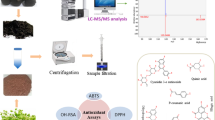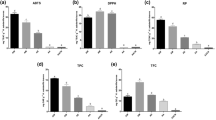Abstract
Punicalagin, a bioactive ellagitannin predominantly found in Pomegranate, has a wide range of health benefits including potent antioxidant properties. The metabolism of punicalagin in human body produces urolithins and ellagic acid. Ellagic acid is a natural phenolic antioxidant and is also known for its antiproliferative activities. Terminalia ferdinandiana (Kakadu plum) was reported to be a rich source of ellagic acid. In this study, an UHPLC-MS/MS method was developed and validated for accurate determination of ellagic acid levels and bioactive ellagitannins (punicalagin and castalagin). Total ellagic acid content in the fruits and leaves were 2.76 and 9.54 g/100 g DW. Punicalagin contents in the fruits and leaves were 74 and 49 mg/100 g DW, and castalagin contents were 1.1 and 0.8 mg/100 g DW. To the best of our knowledge, this is the first report about punicalagin and castalagin concentrations in Kakadu plum fruits and leaves. The findings are very promising regarding the potential use of Kakadu plum fruit and leaf extracts as natural preservatives in the food industry.






Similar content being viewed by others
References
Aguilera-Carbo AF, Augur C, Prado-Barragan LA, Aguilar CN, Favela-Torres E (2008) Extraction and analysis of ellagic acid from novel complex sources. Chem Pap 62:440–444
Akter S, Netzel ME, Tinggi U, Osborne SA, Fletcher MT, Sultanbawa Y (2019) Antioxidant rich extracts of Terminalia ferdinandiana inhibit the growth of foodborne bacteria. Foods 8:281
Assuncao PID, Conceicao ECd, Borges LL,Paula JAMd (2017) Development and validation of a HPLC-UV method for the evaluation of ellagic acid in liquid extracts of Eugenia uniflora L. (Myrtaceae) leaves and its ultrasound-assisted extraction optimization. Evid Based Complement Alternat Med 1501038
Bala I, Bhardwaj V, Hariharan S, Kumar MN (2006) Analytical methods for assay of ellagic acid and its solubility studies. J Pharm Biomed Anal 40:206–210
Campo M, Pinelli P, Romani A (2016) Hydrolyzable tannins from sweet chestnut fractions obtained by a sustainable and eco-friendly industrial process. Nat Prod Commun 11:409–415
Carroll A (1985) Yellow-wood springbacks: a problem for cattle. Queensland Agric J III(I)
Courtney R, Sirdaarta J, Matthews B, Cock IE (2015) Tannin components and inhibitory activity of Kakadu plum leaf extracts against microbial triggers of autoimmune inflammatory diseases. Pharmacognosy Journal 7:18–31
Filippich L, Cao G (1993) Experimental acute yellow-wood (Terminalia oblongata) intoxication in sheep. Aust Vet J 70:214–218
Filippich LJ, Zhu J, Oelrichs P, Alsalami MT, Doig AJ, Cao GR, English PB (1991) Hepatotoxic and nephrotoxic principles in Terminalia oblongata. Res Vet Sci 50:170–177
Fischer UA, Carle R, Kammerer DR (2011) Identification and quantification of phenolic compounds from pomegranate (Punica granatum L.) peel, mesocarp, aril and differently produced juices by HPLC-DAD–ESI/MSn. Food Chem 127(2):807–821
Garcia-Villalba R, Espin JC, Aaby K, Alasalvar C, Heinonen M, Jacobs G, . . . Tomas-Barberan FA (2015) Validated method for the characterization and quantification of extractable and nonextractable ellagitannins after acid hydrolysis in pomegranate fruits, juices, and extracts. J Agric Food Chem 63:6555-6566
Gil MI, Tomás-Barberán FA, Hess-Pierce B, Holcroft DM, Kader AA (2000) Antioxidant activity of pomegranate juice and its relationship with phenolic composition and processing. J Agric Food Chem 48:4581–4589
Hager TJ, Howard LR, Liyanage R, Lay JO, Prior RL (2008) Ellagitannin composition of blackberry as determined by HPLC-ESI-MS and MALDI-TOF-MS. J Agric Food Chem 56:661–669
International Conference on Harmonization. (2005). Validation of analytical procedures: text and methodology. Q2 (R1), 1(20), 05. Retrieved from https://www.fda.gov/regulatory-information/search-fda-guidance-documents/q2-r1-validation-analytical-procedures-text-and-methodology. Accessed Apr 2020
Iwatake M, Okamoto K, Tanaka T, Tsukuba T (2015) Castalagin exerts inhibitory effects on osteoclastogenesis through blocking a broad range of signaling pathways with low cytotoxicity. Phytother Res 29:917–924
Konczak I, Maillot F, Dalar A (2014) Phytochemical divergence in 45 accessions of Terminalia ferdinandiana (Kakadu plum). Food Chem 151:248–256
Lu J, Ding K, Yuan Q (2008) Determination of punicalagin isomers in pomegranate husk. Chromatographia 68:303–306
Marzouk MSA, El-Toumy SA, Moharram FA, Shalaby NM, Ahmed AA (2002) Pharmacologically active ellagitannins from Terminalia myriocarpa. Planta Med 68:523–527
Mininel FJ, Leonardo Junior CS, Espanha LG, Resende FA, Varanda EA, Leite CQF, . . . Dos Santos LC (2014) Characterization and quantification of compounds in the hydroalcoholic extract of the leaves from Terminalia catappa Linn. (Combretaceae) and their mutagenic activity. Evid Based Complement Alternat Med 2014
NATA. (2012). Guidelines for the validation and verification of quantitative and qualitative test methods: NATA Australia. National Association of Testing Authorities (NATA), Australia
Nowak A, Sojka M, Klewicka E, Lipinska L, Klewicki R, Kolodziejczyk K (2017) Ellagitannins from Rubus idaeus L. Exert geno- and cytotoxic effects against human colon adenocarcinoma cell line Caco-2. J Agric Food Chem 65:2947–2955
Okuda T, Yoshida T, Hatano T,Ito H (2009) Ellagitannins renewed the concept of tannins. Chemistry and biology of ellagitannins: an underestimated class of bioactive plant polyphenols pp 1–54
Rasines-Perea Z, Jacquet R, Jourdes M, Quideau S, Teissedre PL (2019) Ellagitannins and flavano-ellagitannins: Red wines tendency in different areas, barrel origin and ageing time in barrel and bottle. Biomolecules 9:316
Rellán-Álvarez R, López-Gomollón S, Abadía J, Álvarez-Fernández A (2011) Development of a new high-performance liquid chromatography–electrospray ionization time-of-flight mass spectrometry method for the determination of low molecular mass organic acids in plant tissue extracts. J Agric Food Chem 59:6864–6870
Shuaibu MN, Pandey K, Wuyep PA, Yanagi T, Hirayama K, Ichinose A, . . . Kouno I (2008) Castalagin from Anogeissus leiocarpus mediates the killing of Leishmania in vitro. Parasitol Res 103:1333-1338
Sirdaarta J, Matthews B, Cock IE (2015) Kakadu plum fruit extracts inhibit growth of the bacterial triggers of rheumatoid arthritis: Identification of stilbene and tannin components. J Funct Foods 17:610–620
Sobeh M, Mahmoud MF, Hasan RA, Abdelfattah MAO, Osman S, Rashid HO, . . . Wink M (2019) Chemical composition, antioxidant and hepatoprotective activities of methanol extracts from leaves of Terminalia bellirica and Terminalia sericea (Combretaceae). PeerJ 7: e6322.
Williams D, Edwards D, Chaliha M, Sultanbawa Y (2016a) Measuring free ellagic acid: Influence of extraction conditions on recovery by studying solubility and UV-Visible spectra. Chem Pap 70:1078–1086
Williams D, Edwards D, Chaliha M, Sultanbawa Y (2016b) Measuring the three forms of ellagic acid: suitability of extraction solvents. Chem Pap 70:144–152
Williams D, Edwards D, Pun S, Chaliha M, Sultanbawa Y (2014) Profiling ellagic acid content: The importance of form and ascorbic acid levels. Food Res Int 66:100–106
Yamada H, Wakamori S, Hirokane T, Ikeuchi K, Matsumoto S (2018) Structural revisions in natural ellagitannins. Molecules 23(8):1901
Yan L, Yin P, Ma C, Liu Y (2014) Method development and validation for pharmacokinetic and tissue distributions of ellagic acid using ultrahigh performance liquid chromatography-tandem mass spectrometry (UPLC-MS/MS). Molecules 19:1420–3049
Yoshida T, Amakura Y, Yoshimura M (2010) Structural features and biological properties of ellagitannins in some plant families of the order Myrtales. Int J Mol Sci 11:79–106
Funding
This project was funded by AgriFutures Australia Grant 201430161. Saleha Akter’s PhD was supported by an Australian Government Research Training Program Scholarship and the University of Queensland.
Author information
Authors and Affiliations
Contributions
SA, MN, MF, and YS conceived and designed the study. SA performed the experiments, analysed data, and wrote the manuscript. HH helped in performing the experiments, obtaining, interpreting, and analysing the data and drafting the manuscript. HH, MN, UT, SO, MF, and YS critically revised and edited the manuscript. All authors approved the final manuscript.
Corresponding author
Ethics declarations
Ethics Approval
This article does not contain any studies with human participants or animals performed by any of the authors.
Informed Consent
Informed consent is not applicable.
Conflict of interest
Saleha Akter declares that she has no conflict of interest. Hung Hong declares that he has no conflict of interest. Michael Netzel declares that he has no conflict of interest. Ujang Tinggi declares that he has no conflict of interest. Mary Fletcher declares that she has no conflict of interest. Simone Osborne declares that she has no conflict of interest. Yasmina Sultanbawa declares that she has no conflict of interest.
Additional information
Publisher’s Note
Springer Nature remains neutral with regard to jurisdictional claims in published maps and institutional affiliations.
Rights and permissions
About this article
Cite this article
Akter, S., Hong, H., Netzel, M. et al. Determination of Ellagic Acid, Punicalagin, and Castalagin from Terminalia ferdinandiana (Kakadu plum) by a Validated UHPLC-PDA-MS/MS Methodology. Food Anal. Methods 14, 2534–2544 (2021). https://doi.org/10.1007/s12161-021-02063-8
Received:
Accepted:
Published:
Issue Date:
DOI: https://doi.org/10.1007/s12161-021-02063-8




